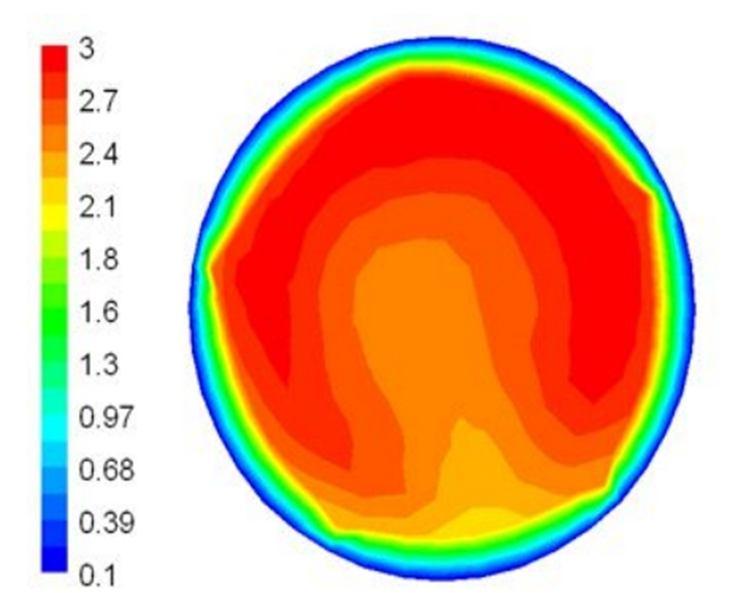
2 minute read
International Journal for Research in Applied Science & Engineering Technology (IJRASET)
from Computational Analysis of Erosion Wear Rate by Multiphase Flow in Optimum Bend Ratio of Pipeline
by IJRASET


Advertisement




ISSN: 2321-9653; IC Value: 45.98; SJ Impact Factor: 7.538
Volume 11 Issue IV Apr 2023- Available at www.ijraset.com
ISSN: 2321-9653; IC Value: 45.98; SJ Impact Factor: 7.538
Volume 11 Issue IV Apr 2023- Available at www.ijraset.com
IV. CONCLUSION
Based on the simulations conducted, the results suggest that the Eulerian model is quite effective to simulate two-phase flow in horizontal pipe bends. Apart from this some other conclusions based on this simulation includes:
1) The risk is higher to outer pipe bends walls due to aggressive erosion rate
2) Even if the solid concentration was lower, the erosion rate was observed to be twice the industrial erosion rate in straight pipelines
3) Higher solid concentration at walls near pipe bends must be one of the reasons for higher erosion rate
4) The velocity and concentration profile was observed to be unaffected by the pipe bend in upstream part of pipe
5) The solids were observed to be redistribution at downstream part of the bend. This could be due to secondary flows
References
[1] Bahadur, S. and Badruddin, R., 1990. Erodent particle characterization and the effect of particle size and shape on erosion. Wear, 138(1-2), pp.189-208.
[2] Desale, G.R., Gandhi, B.K. and Jain, S.C., 2006. Effect of erodent properties on erosion wear of ductile type materials. Wear, 261(7-8), pp.914-921.
[3] Singh, G., Kumar, S. and Sehgal, S.S., 2018. Taguchi approach to erosion wear optimization of WC-10Co-4Cr sprayed austenitic steel subjected to equisized slurry. Industrial Lubrication and Tribology
[4] Deng, T., Bingley, M.S. and Bradley, M.S., 2004. The influence of particle rotation on the solid particle erosion rate of metals. Wear, 256(11-12), pp.10371049.
[5] Heilbronner, R. and Keulen, N., 2006. Grain size and grain shape analysis of fault rocks. Tectonophysics, 427(1-4), pp.199-216.
[6] Gupta, R., Singh, S.N. and Sehadri, V., 1996. Prediction of uneven wear in a slurry pipeline on the basis of measurements in a pot tester. International Journal of Multiphase Flow, 22(S1), pp.152-152.
[7] Desale, G.R., Gandhi, B.K. and Jain, S.C., 2006. Effect of erodent properties on erosion wear of ductile type materials. Wear, 261(7-8), pp.914-921.
[8] Gupta, R., Singh, S.N. and Sehadri, V., 1995. Prediction of uneven wear in a slurry pipeline on the basis of measurements in a pot tester. Wear, 184(2), pp.169178.
[9] Kumar, R., Bhandari, S. and Goyal, A., 2017. Slurry erosion performance of high-velocity flame-sprayed Ni-20Al2O3 and Ni-10Al2O3-10TiO2 coatings under accelerated conditions. Journal of Thermal Spray Technology, 26(6), pp.1279-1291.
[10] Round, G.F. and Hessari, A.R., 1987. Rheology of coal slurries, pH and size distribution effects. Particulate and Multiphase Processes, 3, pp.329-340.
[11] Singh, M.K., Kumar, S. and Ratha, D., 2020. Computational analysis on disposal of coal slurry at high solid concentrations through slurry pipeline. International Journal of Coal Preparation and Utilization, 40(2), pp.116-130.
[12] Singh, K.P., Kumar, A. and Kaushal, D.R., 2022. Experimental investigation on effects of solid concentration, chemical additives, and shear rate on the rheological properties of bottom ash (BA) slurry. International Journal of Coal Preparation and Utilization, 42(3), pp.609-622.

[13] KALYANARAMAN, K. and AJ, R., 1973. CHARACTERISTICS OF SAND-WATER SLURRY IN 90OHORIZONTAL PIPE BENDS.
[14] Turian, R.M., Ma, T.W., Hsu, F.L., Sung, M.J. and Plackmann, G.W., 1998. Flow of concentrated non-Newtonian slurries: 2. Friction losses in bends, fittings, valves and venturi meters. International journal of multiphase flow, 24(2), pp.243-269.
[15] Bozzini, B., Ricotti, M.E., Boniardi, M. and Mele, C., 2003. Evaluation of erosion–corrosion in multiphase flow via CFD and experimental analysis. Wear, 255(1-6), pp.237-245.
[16] Mansouri, A., Arabnejad, H., Shirazi, S.A. and McLaury, B.S., 2015. A combined CFD/experimental methodology for erosion prediction. Wear, 332, pp.10901097.

[17] Njobuenwu, D.O. and Fairweather, M., 2012. Modelling of pipe bend erosion by dilute particle suspensions. Computers & Chemical Engineering, 42, pp.235247.
[18] Ito, H., 1960. Pressure losses in smooth pipe bends.
[19] Kaushal, D.R., Kumar, A., Tomita, Y., Kuchii, S. and Tsukamoto, H., 2013. Flow of mono-dispersed particles through horizontal bend. International Journal of Multiphase Flow, 52, pp.71-91.
[20] Drew, D.A., Lahey, R.T., 1993. Particulate Two – Phase Flow. Butterworth-Heinemann Publications, Boston, pp. 509–566.


